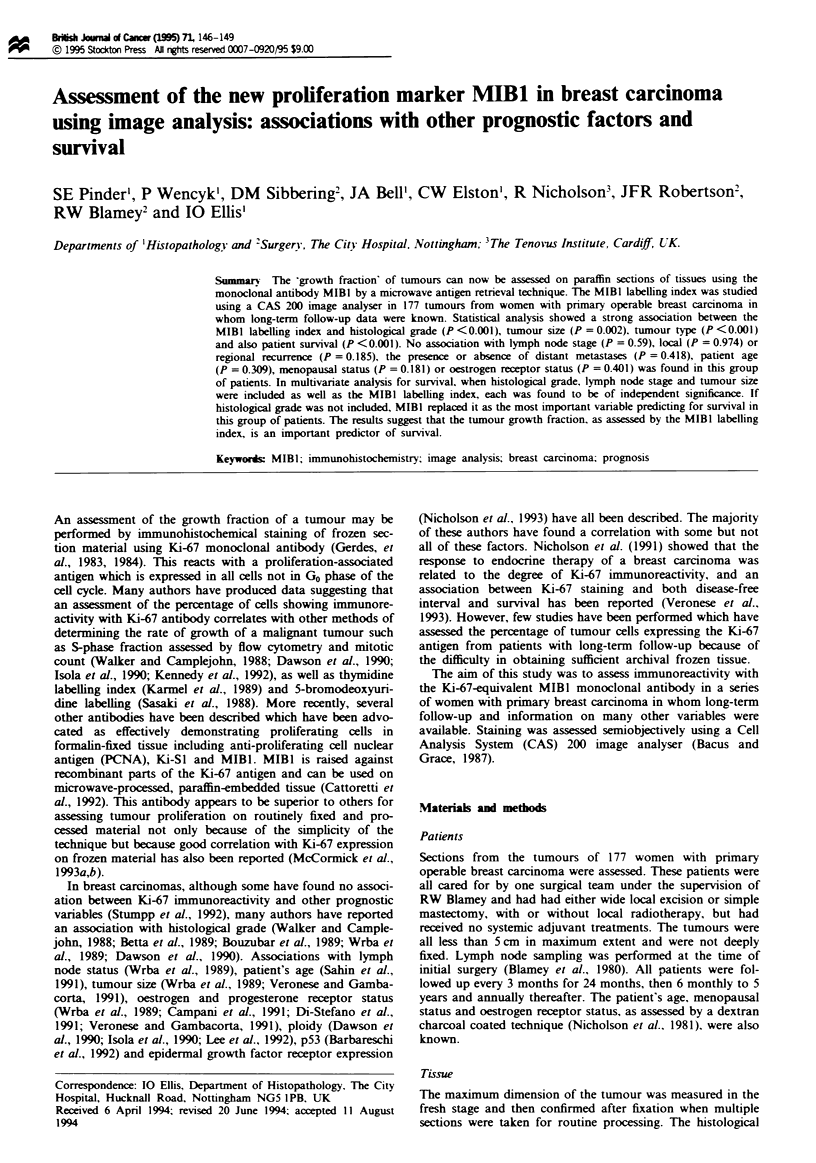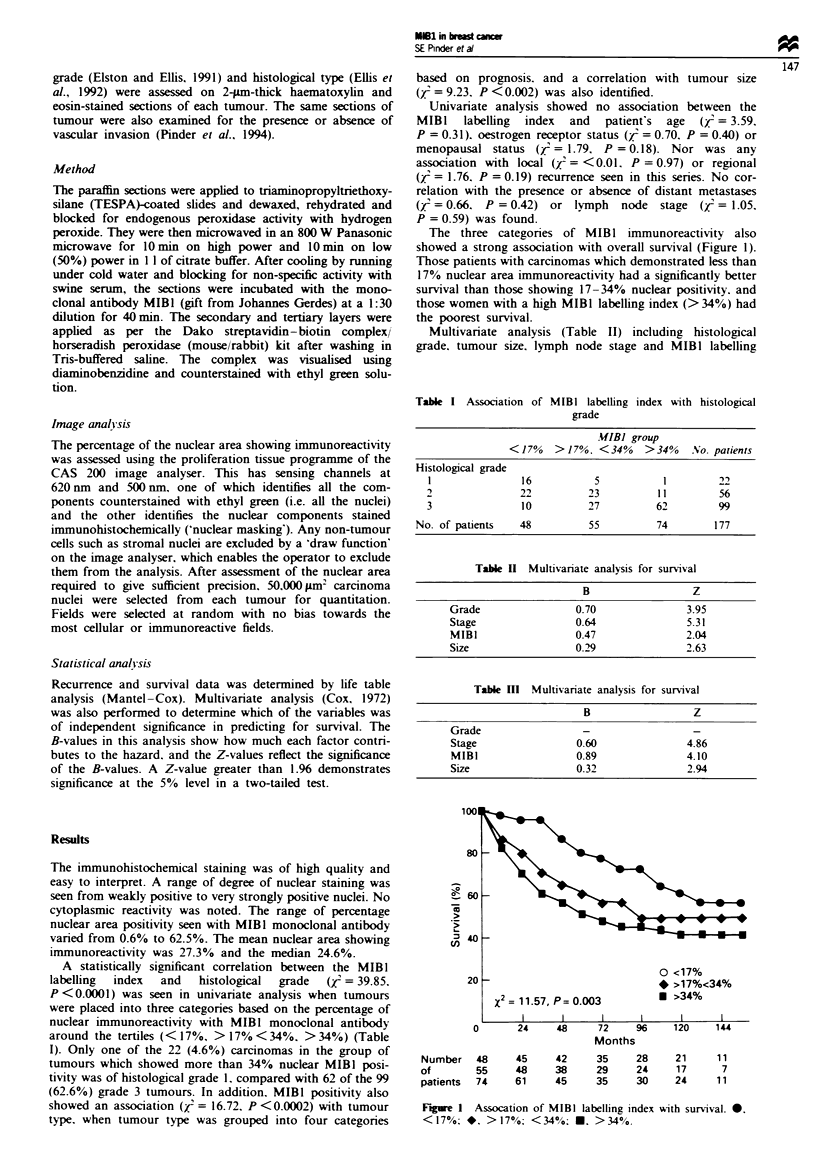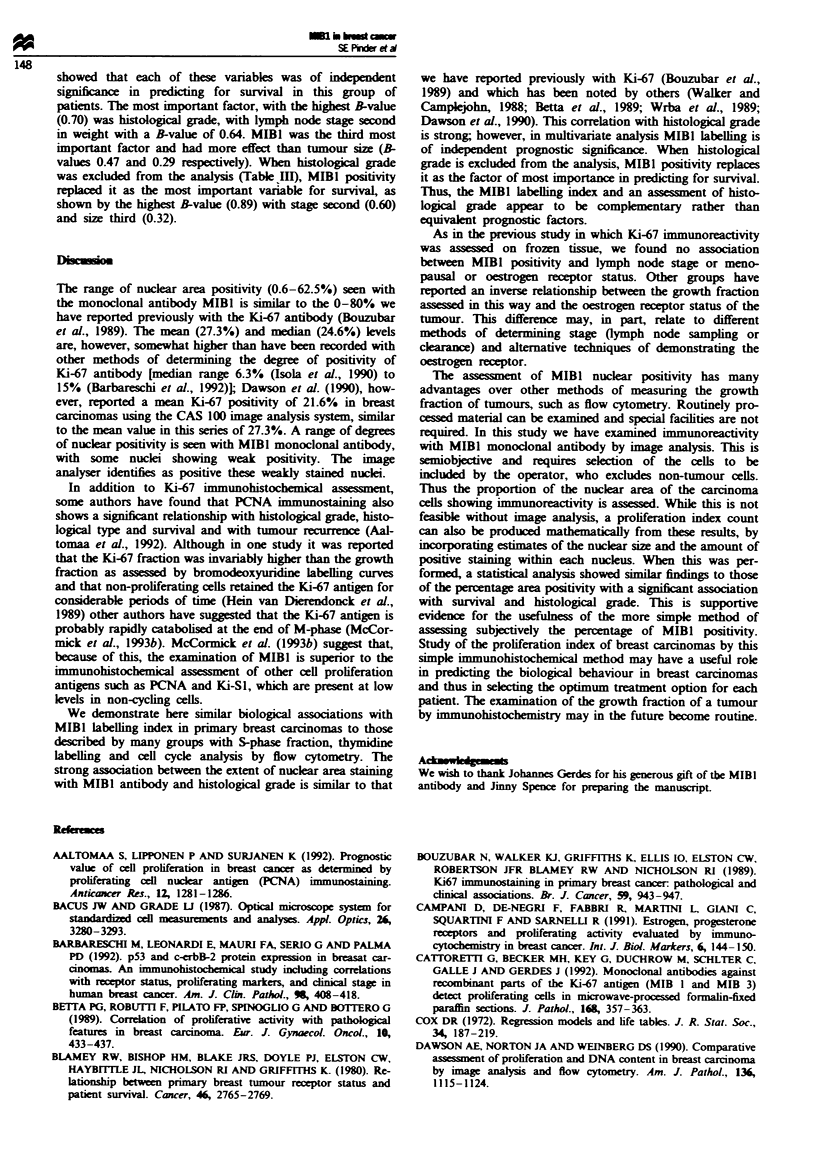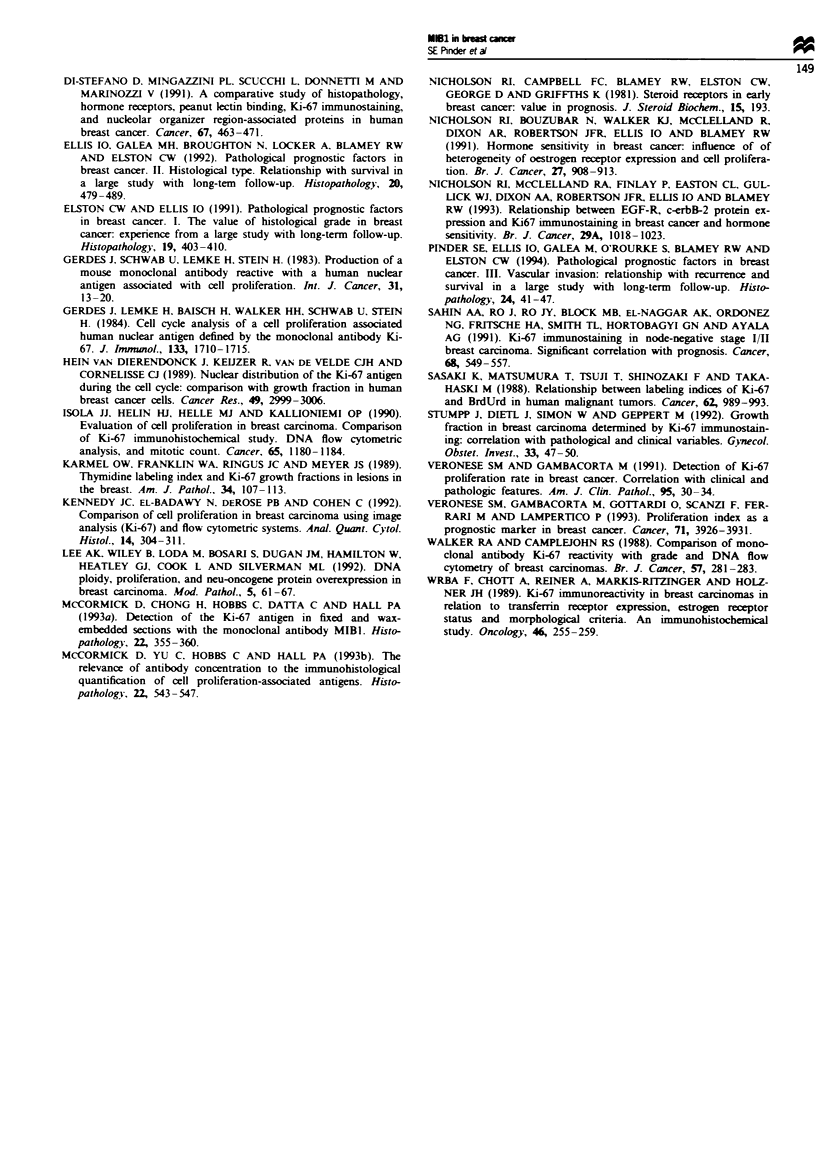Abstract
The 'growth fraction' of tumours can now be assessed on paraffin sections of tissues using the monoclonal antibody MIB1 by a microwave antigen retrieval technique. The MIB1 labelling index was studied using a CAS 200 image analyser in 177 tumours from women with primary operable breast carcinoma in whom long-term follow-up data were known. Statistical analysis showed a strong association between the MIB1 labelling index and histological grade (P < 0.001), tumour size (P = 0.002), tumour type (P < 0.001) and also patient survival (P < 0.001). No association with lymph node stage (P = 0.974) or regional recurrence (P = 0.185), the presence or absence of distant metastases (P = 0.418), patient age (P = 0.309), menopausal status (P = 0.181) or oestrogen receptor status (P = 0.401) was found in this group of patients. In multivariate analysis for survival, when histological grade, lymph node stage and tumour size were included as well as the MIB1 labelling index, each was found to be of independent significance. If histological grade was not included, MIB1 replaced it as the most important variable predicting for survival in this group of patients. The results suggest that the tumour growth fraction, as assessed by the MIB1 labelling index, is an important predictor of survival.
Full text
PDF



Selected References
These references are in PubMed. This may not be the complete list of references from this article.
- Aaltomaa S., Lipponen P., Syrjänen K. Prognostic value of cell proliferation in breast cancer as determined by proliferating cell nuclear antigen (PCNA) immunostaining. Anticancer Res. 1992 Jul-Aug;12(4):1281–1286. [PubMed] [Google Scholar]
- Barbareschi M., Leonardi E., Mauri F. A., Serio G., Dalla Palma P. p53 and c-erbB-2 protein expression in breast carcinomas. An immunohistochemical study including correlations with receptor status, proliferation markers, and clinical stage in human breast cancer. Am J Clin Pathol. 1992 Oct;98(4):408–418. doi: 10.1093/ajcp/98.4.408. [DOI] [PubMed] [Google Scholar]
- Betta P. G., Robutti F., Pilato F. P., Spinoglio G., Bottero G. Correlation of proliferative activity with pathological features in breast carcinoma. Eur J Gynaecol Oncol. 1989;10(6):433–437. [PubMed] [Google Scholar]
- Blamey R. W., Bishop H. M., Blake J. R., Doyle P. J., Elston C. W., Haybittle J. L., Nicholson R. I., Griffiths K. Relationship between primary breast tumor receptor status and patient survival. Cancer. 1980 Dec 15;46(12 Suppl):2765–2769. doi: 10.1002/1097-0142(19801215)46:12+<2765::aid-cncr2820461404>3.0.co;2-c. [DOI] [PubMed] [Google Scholar]
- Bouzubar N., Walker K. J., Griffiths K., Ellis I. O., Elston C. W., Robertson J. F., Blamey R. W., Nicholson R. I. Ki67 immunostaining in primary breast cancer: pathological and clinical associations. Br J Cancer. 1989 Jun;59(6):943–947. doi: 10.1038/bjc.1989.200. [DOI] [PMC free article] [PubMed] [Google Scholar]
- Campani D., De Negri F., Fabbri R., Martini L., Giani C., Squartini F., Sarnelli R. Estrogen, progesterone receptors and proliferating activity evaluated by immunocytochemistry in breast cancer. Int J Biol Markers. 1991 Jul-Sep;6(3):144–150. doi: 10.1177/172460089100600302. [DOI] [PubMed] [Google Scholar]
- Cattoretti G., Becker M. H., Key G., Duchrow M., Schlüter C., Galle J., Gerdes J. Monoclonal antibodies against recombinant parts of the Ki-67 antigen (MIB 1 and MIB 3) detect proliferating cells in microwave-processed formalin-fixed paraffin sections. J Pathol. 1992 Dec;168(4):357–363. doi: 10.1002/path.1711680404. [DOI] [PubMed] [Google Scholar]
- Dawson A. E., Norton J. A., Weinberg D. S. Comparative assessment of proliferation and DNA content in breast carcinoma by image analysis and flow cytometry. Am J Pathol. 1990 May;136(5):1115–1124. [PMC free article] [PubMed] [Google Scholar]
- Di Stefano D., Mingazzini P. L., Scucchi L., Donnetti M., Marinozzi V. A comparative study of histopathology, hormone receptors, peanut lectin binding, Ki-67 immunostaining, and nucleolar organizer region-associated proteins in human breast cancer. Cancer. 1991 Jan 15;67(2):463–471. doi: 10.1002/1097-0142(19910115)67:2<463::aid-cncr2820670224>3.0.co;2-o. [DOI] [PubMed] [Google Scholar]
- Ellis I. O., Galea M., Broughton N., Locker A., Blamey R. W., Elston C. W. Pathological prognostic factors in breast cancer. II. Histological type. Relationship with survival in a large study with long-term follow-up. Histopathology. 1992 Jun;20(6):479–489. doi: 10.1111/j.1365-2559.1992.tb01032.x. [DOI] [PubMed] [Google Scholar]
- Elston C. W., Ellis I. O. Pathological prognostic factors in breast cancer. I. The value of histological grade in breast cancer: experience from a large study with long-term follow-up. Histopathology. 1991 Nov;19(5):403–410. doi: 10.1111/j.1365-2559.1991.tb00229.x. [DOI] [PubMed] [Google Scholar]
- Gerdes J., Lemke H., Baisch H., Wacker H. H., Schwab U., Stein H. Cell cycle analysis of a cell proliferation-associated human nuclear antigen defined by the monoclonal antibody Ki-67. J Immunol. 1984 Oct;133(4):1710–1715. [PubMed] [Google Scholar]
- Gerdes J., Schwab U., Lemke H., Stein H. Production of a mouse monoclonal antibody reactive with a human nuclear antigen associated with cell proliferation. Int J Cancer. 1983 Jan 15;31(1):13–20. doi: 10.1002/ijc.2910310104. [DOI] [PubMed] [Google Scholar]
- Isola J. J., Helin H. J., Helle M. J., Kallioniemi O. P. Evaluation of cell proliferation in breast carcinoma. Comparison of Ki-67 immunohistochemical study, DNA flow cytometric analysis, and mitotic count. Cancer. 1990 Mar 1;65(5):1180–1184. doi: 10.1002/1097-0142(19900301)65:5<1180::aid-cncr2820650525>3.0.co;2-7. [DOI] [PubMed] [Google Scholar]
- Kamel O. W., Franklin W. A., Ringus J. C., Meyer J. S. Thymidine labeling index and Ki-67 growth fraction in lesions of the breast. Am J Pathol. 1989 Jan;134(1):107–113. [PMC free article] [PubMed] [Google Scholar]
- Kennedy J. C., el-Badawy N., DeRose P. B., Cohen C. Comparison of cell proliferation in breast carcinoma using image analysis (Ki-67) and flow cytometric systems. Anal Quant Cytol Histol. 1992 Aug;14(4):304–311. [PubMed] [Google Scholar]
- Lee A. K., Wiley B., Loda M., Bosari S., Dugan J. M., Hamilton W., Heatley G. J., Cook L., Silverman M. L. DNA ploidy, proliferation, and neu-oncogene protein overexpression in breast carcinoma. Mod Pathol. 1992 Jan;5(1):61–67. [PubMed] [Google Scholar]
- McCormick D., Chong H., Hobbs C., Datta C., Hall P. A. Detection of the Ki-67 antigen in fixed and wax-embedded sections with the monoclonal antibody MIB1. Histopathology. 1993 Apr;22(4):355–360. doi: 10.1111/j.1365-2559.1993.tb00135.x. [DOI] [PubMed] [Google Scholar]
- McCormick D., Yu C., Hobbs C., Hall P. A. The relevance of antibody concentration to the immunohistological quantification of cell proliferation-associated antigens. Histopathology. 1993 Jun;22(6):543–547. doi: 10.1111/j.1365-2559.1993.tb00174.x. [DOI] [PubMed] [Google Scholar]
- Nicholson R. I., Bouzubar N., Walker K. J., McClelland R., Dixon A. R., Robertson J. F., Ellis I. O., Blamey R. W. Hormone sensitivity in breast cancer: influence of heterogeneity of oestrogen receptor expression and cell proliferation. Eur J Cancer. 1991;27(7):908–913. doi: 10.1016/0277-5379(91)90145-4. [DOI] [PubMed] [Google Scholar]
- Nicholson R. I., Campbell F. C., Blamey R. W., Elston C. W., George D., Griffiths K. Steroid receptors in early breast cancer: value in prognosis. J Steroid Biochem. 1981 Dec;15:193–199. doi: 10.1016/0022-4731(81)90275-2. [DOI] [PubMed] [Google Scholar]
- Nicholson R. I., McClelland R. A., Finlay P., Eaton C. L., Gullick W. J., Dixon A. R., Robertson J. F., Ellis I. O., Blamey R. W. Relationship between EGF-R, c-erbB-2 protein expression and Ki67 immunostaining in breast cancer and hormone sensitivity. Eur J Cancer. 1993;29A(7):1018–1023. doi: 10.1016/s0959-8049(05)80215-1. [DOI] [PubMed] [Google Scholar]
- Pinder S. E., Ellis I. O., Galea M., O'Rouke S., Blamey R. W., Elston C. W. Pathological prognostic factors in breast cancer. III. Vascular invasion: relationship with recurrence and survival in a large study with long-term follow-up. Histopathology. 1994 Jan;24(1):41–47. doi: 10.1111/j.1365-2559.1994.tb01269.x. [DOI] [PubMed] [Google Scholar]
- Sahin A. A., Ro J., Ro J. Y., Blick M. B., el-Naggar A. K., Ordonez N. G., Fritsche H. A., Smith T. L., Hortobagyi G. N., Ayala A. G. Ki-67 immunostaining in node-negative stage I/II breast carcinoma. Significant correlation with prognosis. Cancer. 1991 Aug 1;68(3):549–557. doi: 10.1002/1097-0142(19910801)68:3<549::aid-cncr2820680318>3.0.co;2-j. [DOI] [PubMed] [Google Scholar]
- Sasaki K., Matsumura K., Tsuji T., Shinozaki F., Takahashi M. Relationship between labeling indices of Ki-67 and BrdUrd in human malignant tumors. Cancer. 1988 Sep 1;62(5):989–993. doi: 10.1002/1097-0142(19880901)62:5<989::aid-cncr2820620525>3.0.co;2-u. [DOI] [PubMed] [Google Scholar]
- Stumpp J., Dietl J., Simon W., Geppert M. Growth fraction in breast carcinoma determined by Ki-67 immunostaining: correlation with pathological and clinical variables. Gynecol Obstet Invest. 1992;33(1):47–50. doi: 10.1159/000294846. [DOI] [PubMed] [Google Scholar]
- Veronese S. M., Gambacorta M. Detection of Ki-67 proliferation rate in breast cancer. Correlation with clinical and pathologic features. Am J Clin Pathol. 1991 Jan;95(1):30–34. doi: 10.1093/ajcp/95.1.30. [DOI] [PubMed] [Google Scholar]
- Veronese S. M., Gambacorta M., Gottardi O., Scanzi F., Ferrari M., Lampertico P. Proliferation index as a prognostic marker in breast cancer. Cancer. 1993 Jun 15;71(12):3926–3931. doi: 10.1002/1097-0142(19930615)71:12<3926::aid-cncr2820711221>3.0.co;2-2. [DOI] [PubMed] [Google Scholar]
- Walker R. A., Camplejohn R. S. Comparison of monoclonal antibody Ki-67 reactivity with grade and DNA flow cytometry of breast carcinomas. Br J Cancer. 1988 Mar;57(3):281–283. doi: 10.1038/bjc.1988.60. [DOI] [PMC free article] [PubMed] [Google Scholar]
- Wrba F., Chott A., Reiner A., Reiner G., Markis-Ritzinger E., Holzner J. H. Ki-67 immunoreactivity in breast carcinomas in relation to transferrin receptor expression, estrogen receptor status and morphological criteria. An immunohistochemical study. Oncology. 1989;46(4):255–259. doi: 10.1159/000226727. [DOI] [PubMed] [Google Scholar]
- van Dierendonck J. H., Keijzer R., van de Velde C. J., Cornelisse C. J. Nuclear distribution of the Ki-67 antigen during the cell cycle: comparison with growth fraction in human breast cancer cells. Cancer Res. 1989 Jun 1;49(11):2999–3006. [PubMed] [Google Scholar]


